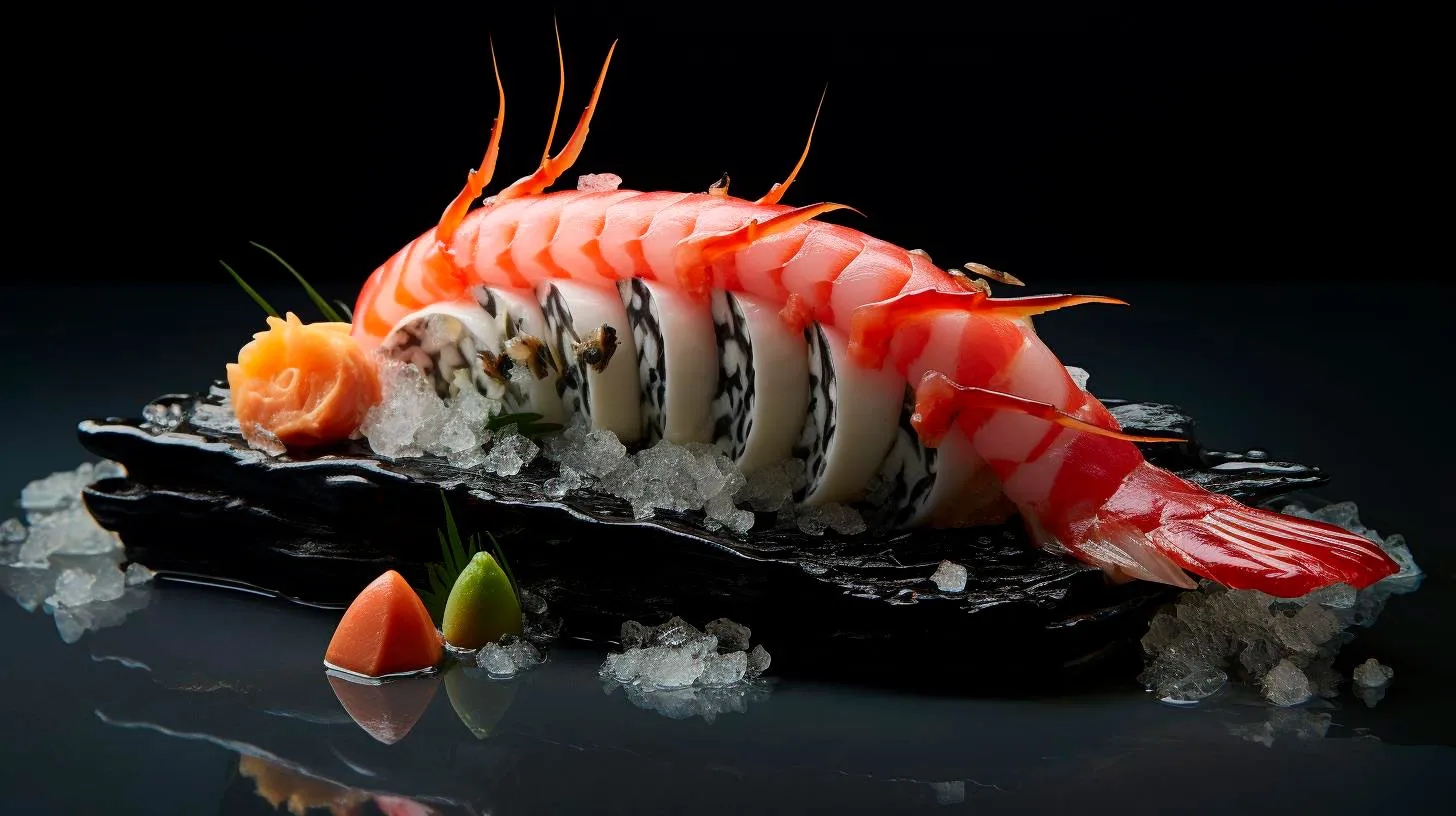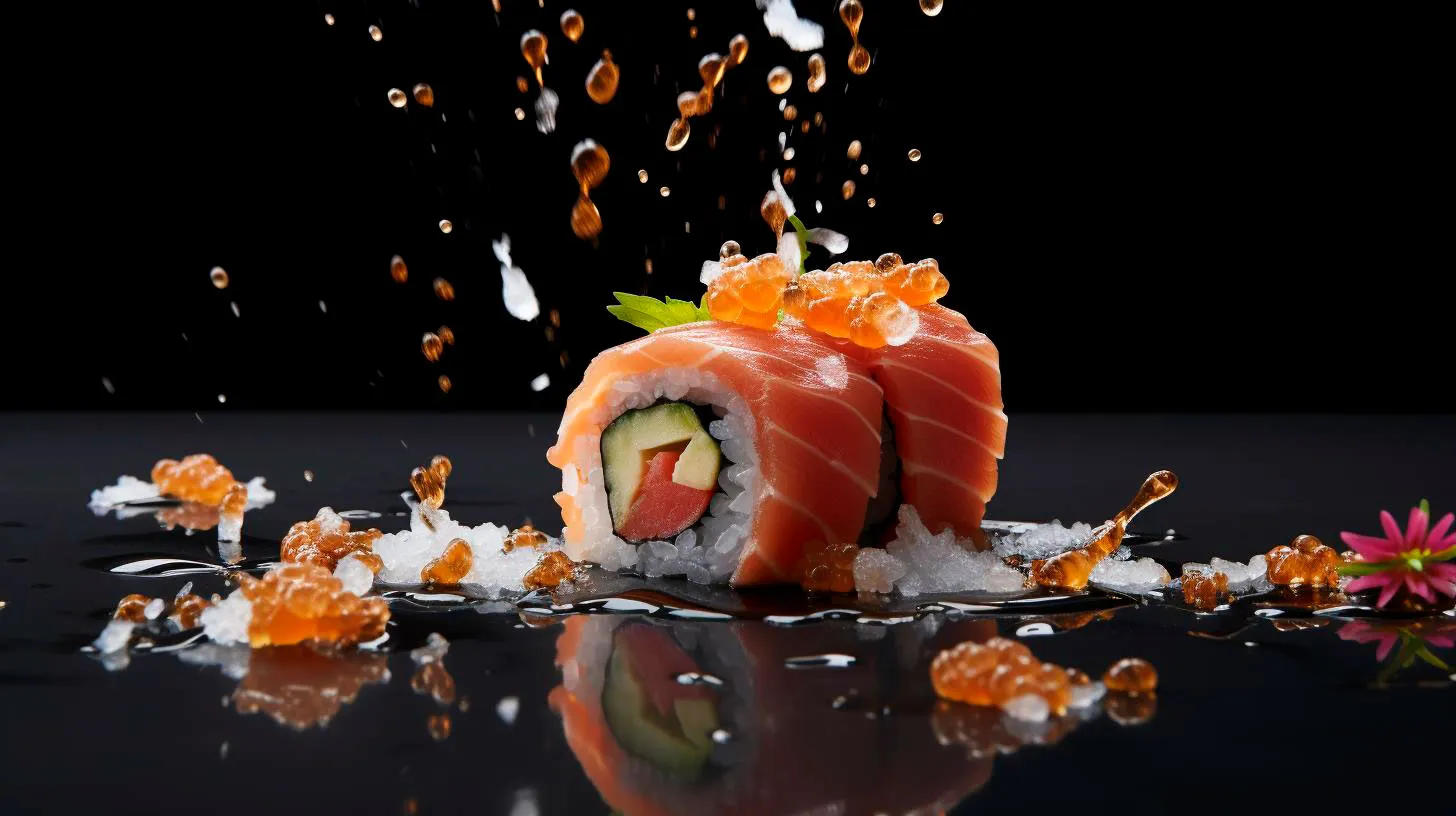Breaking Stereotypes: Redefining Sushi and Sashimi
In this article, we aim to debunk certain stereotypes surrounding sushi and sashimi, and shed light on their true essence. Allow us to take you on a journey of flavors, variety, and creativity that will revolutionize your perception of Japanese cuisine.
The Flavorful Transformation
Traditional sushi and sashimi are known for their simplicity; the focus is usually on the quality and freshness of the raw fish. However, modern sushi chefs are pushing these boundaries, redefining the artistry, and introducing a whole new world of taste sensations. Here are some noteworthy revelations:
- Fusion of Flavors: Sushi has evolved beyond the classic fish and rice combination. Today, you can find inventive combinations of ingredients such as avocado, mango, cream cheese, and even fruits like strawberries. These additions introduce a delightful blend of textures and tastes, making sushi a versatile option for all palates.
- Vegetarian and Vegan Options: Contrary to popular belief, sushi isn’t limited to seafood. Vegetarian and vegan sushi rolls are gaining popularity, offering a wide range of options for those who prefer a plant-based diet. Fillings like tofu, cucumber, sweet potato, and pickled vegetables add a unique twist to traditional rolls.
- Flavorful Delicacies: Sashimi, renowned for the simplicity of raw fish slices, has also witnessed an evolution. Chefs now marinate the fish in various sauces, enhancing the natural flavors and creating an explosion of taste with every bite. From soy sauce and wasabi to citrus-infused dressings, you’ll find an array of creative options to tantalize your taste buds.
The possibilities are endless when it comes to the flavors and combinations available in sushi and sashimi. Whether you prefer traditional or modern variations, these dishes have something for everyone.
Redefining Creativity
Sushi and sashimi – artistic masterpieces plated on simple wooden boards. While their appearance may seem unassuming at first, many sushi chefs have turned these dishes into showcases of their creativity and imagination. Let’s explore:
- Visual Presentation: Sushi chefs now use a wide range of techniques and artistic plating styles to create visually stunning dishes. From elaborate flower shapes made of thinly sliced radishes to colorful mosaics of assorted fish, the presentation of sushi has become an integral part of the dining experience.
- Modern Interpretations: Sushi-making has extended its reach beyond Japan’s borders, enabling global culinary influences to harmonize with this ancient art form. Creative minds have blended elements from different cuisines, resulting in sushi burritos, sushi tacos, and even sushi burgers. These imaginative creations appeal to a younger generation, breaking away from the stereotypical image of traditional sushi.
- Art of Omakase: Omakase, meaning “trust the chef,” has gained popularity in sushi restaurants worldwide. It allows the chef to showcase their expertise and creativity by serving a carefully curated selection of the freshest ingredients available that day. This culinary experience leads to unexpected flavor combinations and surprises, leaving the diner in awe of the masterful creations.
By embracing creativity, sushi and sashimi have become more than just tasty dishes. They have transformed into edible works of art that delight the senses and offer a truly unique dining experience.
Key Takeaways
Breaking stereotypes and redefining sushi and sashimi have opened a world of opportunities, offering numerous advantages to both chefs and diners alike. Here are the key takeaways to remember:
- Modern sushi and sashimi embrace a fusion of flavors, catering to a variety of dietary preferences.
- The use of vegetarian and vegan ingredients expands the options available, making them accessible to a wider audience.
- Enhanced flavors through marinating and innovative dressings elevate the traditional taste experience.
- Chefs have elevated the presentation of sushi and sashimi through artistic plating techniques.
- Global culinary influences have inspired the creation of unique and unconventional sushi variations.
- Omakase allows chefs to personalize the dining experience, surprising diners with culinary masterpieces.
In conclusion, sushi and sashimi have transcended the limitations of tradition, embracing new flavors, styles, and creative presentations. The culinary world continuously evolves, and these Japanese delicacies exemplify how innovation breathes new life into centuries-old traditions. So, the next time you think of sushi or sashimi, remember the broader horizons they represent and the wonderful world they offer for your taste buds to explore!
From Traditional to Fusion: The Evolution of Sushi and Sashimi
In this article, we will explore the journey of sushi and sashimi, from their humble beginnings to their modern and innovative adaptations.
The Traditional Origins
Sushi, dating back to the 7th century in Southeast Asia, was initially created as a way to preserve fish by fermenting it with rice. This technique evolved over time, with vinegared rice being used to replace the fermentation process. In the Edo period, sushi gained popularity in Japan, with Nigiri (hand-pressed sushi) becoming the favored form. Sashimi, on the other hand, emerged as a Japanese delicacy during the Muromachi period and focused solely on the raw fish without any rice or other ingredients.
The Rise of Fusion
The fusion of sushi and sashimi with other cuisines began in the 1960s when chefs started experimenting with different ingredients, flavors, and preparation methods. It marked the birth of fusion sushi, which combined the traditional techniques with influences from other countries. This culinary trend quickly gained recognition and popularity in the United States, with California being at the forefront of sushi fusion.
Key Takeaway: The fusion of sushi and sashimi gave birth to innovative creations that incorporated flavors and ingredients from different cuisines, leading to a culinary revolution.
Advantages of Fusion Sushi and Sashimi
The fusion of sushi and sashimi has several advantages that have contributed to its widespread appeal:
- Expanded Variety: Fusion sushi and sashimi introduce a wider range of flavors and ingredient combinations than traditional sushi. This allows for a more diverse and exciting dining experience.
- Cultural Integration: Fusion sushi embraces ingredients and techniques from different cultures, resulting in a culinary integration that celebrates diversity.
- Appealing to Different Tastes: Fusion sushi and sashimi cater to a broader audience, attracting those who may be new to sushi or prefer familiar flavors.
Fusion Sushi Across the Globe
Fusion sushi has expanded beyond the United States and can now be found in various parts of the world. Here are some notable examples:
Nikkei Sushi: Japan meets Peru
Nikkei sushi is a perfect representation of fusion cuisine, blending Japanese sushi techniques with Peruvian flavors. This unique fusion arose from the migration of Japanese immigrants to Peru in the late 19th and early 20th centuries. Nikkei sushi often incorporates Peruvian ingredients such as aji amarillo chili pepper and traditional Peruvian sauces like anticucho.
Sushi Burritos: Fusion on the Go
Sushi burritos are exactly what they sound like – a fusion of sushi and burritos. Originating in the United States, they combine the convenience of a burrito with the flavors of sushi. Rolled in seaweed wraps, sushi burritos allow for customization and offer a handheld, on-the-go dining experience.
Tempura Sushi: Crunchy Fusion
Tempura sushi blends the traditional method of deep-frying with sushi. This fusion provides a crunchy texture to the dish, with tempura-battered ingredients like shrimp, vegetables, or even sushi rolls. Tempura sushi adds a delightful contrast to the softness of sushi, creating a unique dining experience.
Key Takeaway
Fusion sushi has evolved into a global culinary trend, with various countries infusing their own flavors and ingredients into the traditional sushi and sashimi dishes. This fusion revolutionizes the dining experience, offering new tastes and textures to sushi enthusiasts worldwide.
In Conclusion
The evolution of sushi and sashimi from their traditional origins to fusion creations is a testament to the ever-changing nature of culinary delights. Fusion sushi and sashimi have opened up a world of possibilities, incorporating diverse flavors, ingredients, and techniques from various cultures. Whether it’s Nikkei sushi, sushi burritos, or tempura sushi, these fusion creations continue to captivate food lovers and expand the boundaries of traditional Japanese cuisine.
Sushi and Sashimi: Exploring Their Global Influence
Whether you’ve been a sushi aficionado for years or are just starting to delve into the world of Japanese cuisine, there’s always something new to discover.
The Fascinating History
Before we explore the global influence sushi and sashimi have today, let’s take a step back and understand their roots. These delightful dishes trace their origins back to ancient Japan. Sushi, in its earliest form, was first created as a preservation method, where fish was fermented with rice and salt. Over time, this technique evolved into the sushi we know and love today. Sashimi, on the other hand, refers to thinly-sliced raw fish or seafood, which is often served with soy sauce and wasabi.
Both sushi and sashimi have evolved through the centuries, adapting to regional tastes and preferences. The Edo period in Japan (1603-1868) was particularly crucial in shaping sushi’s modern form, as it transitioned from a street food stall to an upscale dish enjoyed by the wealthy. Fast forward to the 20th century, and sushi gained international attention when it appeared on menus in the United States, eventually capturing the hearts and taste buds of people worldwide.
The Global Influence
The popularity of sushi and sashimi is not limited to Japan. These dishes have traversed borders and have become a staple in many countries around the world. Let’s explore the reasons behind their global appeal:
- Variety of Flavors: Sushi and sashimi offer a wide range of tastes and textures, from delicate white fish to rich and fatty tuna. There’s something to suit every palate.
- Health Benefits: With their emphasis on fresh ingredients, sushi and sashimi are often considered healthier alternatives to other cuisines. They are low in fat, high in protein, and packed with essential nutrients.
- Vegetarian and Vegan Options: Sushi isn’t limited to seafood lovers. Vegetarian and vegan sushi options, such as avocado rolls and cucumber rolls, cater to a variety of dietary preferences.
- Cultural Appeal: Sushi has become a cultural symbol of Japan, representing elegance, craftsmanship, and attention to detail. Its cultural allure attracts tourists and locals alike.
The Rise of Sushi Restaurants
Over the years, sushi restaurants have mushroomed across the globe, catering to the growing demand for this popular cuisine. Let’s take a closer look at the impact of these establishments:
- Job Creation and Economic Boost: The rise of sushi restaurants has created numerous job opportunities, from sushi chefs to servers, contributing to local economies.
- Cross-Cultural Exchange: Sushi restaurants act as hubs for cultural exchange, allowing people to experience a slice of Japan’s culinary tradition right in their own cities.
- Fusion Cuisine: Many sushi restaurants offer fusion dishes, combining elements of Japanese cuisine with local flavors. This fusion has led to the creation of exciting and unique sushi rolls.
Key Takeaways
Sushi and sashimi have come a long way from their humble beginnings in Japan. Today, these dishes have found a global stage, captivating food enthusiasts worldwide. Here are the key takeaways to remember:
- Sushi and sashimi have a rich history that dates back centuries.
- The global influence of sushi and sashimi can be attributed to their variety of flavors, health benefits, and cultural appeal.
- Sushi restaurants have played a significant role in spreading the popularity of these dishes, contributing to job creation and cross-cultural exchange.
So, the next time you sit down at a sushi restaurant or indulge in a platter of sashimi, remember the fascinating journey these dishes have taken to reach your plate. The global influence of sushi and sashimi is a testament to their enduring appeal and the power of culinary traditions to bridge cultures.
Unveiling the Intricacies of Sushi and Sashimi Preparation
Sushi: A Delightful Combination of Simplicity and Sophistication
Sushi originated in Japan and has become a global sensation due to its simplicity and harmonious flavors. It consists of vinegared rice combined with a variety of fresh ingredients, such as raw or cooked seafood, vegetables, and even tropical fruits. The combination of flavors, textures, and colors in sushi makes it an absolute delight.
The Art of Making Sushi Rice
One of the most crucial aspects of sushi preparation is the rice. Sushi rice is the foundation of any sushi dish, providing the perfect balance of taste and texture. Here are some key points to remember when making sushi rice:
- Wash the rice thoroughly before cooking to remove excess starch.
- Use high-quality short-grain rice for the best results.
- Add a blend of rice vinegar, sugar, and salt to create the signature sushi rice flavor.
Perfecting the art of sushi rice is a fundamental skill that every sushi chef must master.
Showcasing Freshness with Sashimi
Sashimi, on the other hand, focuses primarily on the main ingredient, typically slices of impeccably fresh raw fish or seafood. It showcases the purity and freshness of the ingredients, allowing their flavors to shine through. When preparing sashimi, the following factors are crucial:
- Choose the highest quality seafood from reputable suppliers.
- Use sharp knives and precise techniques to create perfectly thin slices.
- Serve sashimi with soy sauce, wasabi, and pickled ginger to enhance the flavors.
Meticulous attention to detail is vital when preparing sashimi to ensure the best dining experience.
Advantages of Sushi and Sashimi
1. Nutritional Benefits: Sushi and sashimi are packed with essential nutrients like omega-3 fatty acids, vitamins, and minerals, thanks to the seafood used in their preparation. These nutrients contribute to heart health, brain function, and overall well-being.
2. Low-Calorie Option: Sushi and sashimi are generally low in calories compared to many other dishes, making them an excellent choice for those watching their calorie intake. They are often enjoyed with a side of fresh vegetables, further enhancing their nutritional value.
3. Culinary Versatility: Sushi and sashimi offer a wide range of options for both seafood lovers and vegetarians alike. From traditional tuna rolls to vegetarian sushi with avocado and cucumber, there is something to please every palate.
4. Cultural Experience: Trying sushi and sashimi provides an opportunity to experience Japanese culture and culinary traditions. It allows us to appreciate the dedication and craftsmanship that goes into their preparation.
Key Takeaways
The world of sushi and sashimi is a fascinating one. Here are the key takeaways from this article:
- Sushi and sashimi are renowned for their delightful flavors and unique presentation.
- Focus on using high-quality ingredients to achieve the best results.
- Mastering the art of sushi rice and precise slicing techniques is essential.
- Sushi and sashimi offer numerous health benefits and culinary versatility.
- Enjoying sushi and sashimi is an opportunity to immerse yourself in Japanese culture.
Whether you are a seasoned sushi enthusiast or new to these delicacies, unraveling the intricacies of their preparation adds a whole new dimension to the dining experience. Now, armed with a better understanding of sushi and sashimi, go ahead and savor these incredible culinary delights.


